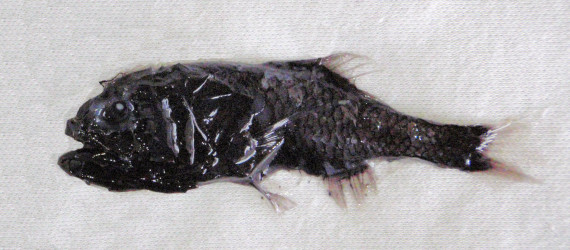Crested Bigscale, Poromitra crassiceps
 Crested Bigscale, Poromitra crassiceps. Fish collected in a deep water trawl net off Point Loma, California, August 2010. Length: 8.1 cm (3.2 inches). Catch and identification courtesy of H.J. Walker, Jr., Scripps Institute of Oceanography, La Jolla, California.
Crested Bigscale, Poromitra crassiceps. Fish collected in a deep water trawl net off Point Loma, California, August 2010. Length: 8.1 cm (3.2 inches). Catch and identification courtesy of H.J. Walker, Jr., Scripps Institute of Oceanography, La Jolla, California.
The Crested Bigscale, Poromitra crassiceps, is a member of the Bigscale and Ridgehead or Melamphaidae Family, that is known in Mexico as aletudo crestada. Globally, there are thirty-seven species in the family placed in five genera. For the Poromitra Genus there are twenty-two global member members, of which three are found in Mexican waters, all in the Pacific Ocean.
The Crested Bigscale has an elongated rectangular body with a serrated crest on top of their head. They are black with dark fins. Their anal fin has 1 spine and 8 to 11 rays; their caudal fin is shallow and forked; their dorsal fin has 3 spines and 11 to 14 rays; and, their pectoral fins are long being longer than the head and slender.
The Crested Bigscale is a mesopelagic and bathypelagic species found at depths between 136 m (450 feet) and 4,000 m (13,120 feet). Juveniles are found in shallower water than adults. They reach a maximum of 19.0 cm (7.5 inches) in length. They migrate vertically toward the surface for feeding during the night to feed on small crustaceans. They are oviparous producing planktonic eggs and larvae and have a lifespans of nine years. The Crested Bigscale is poorly studied with very limited information available about their lifestyle and behavioral patterns including specific details on age, growth, longevity, movement patterns, diet, habitat use, and reproduction.
The Crested Bigscale is a resident of all Mexican waters of the Pacific Ocean.
The Crested Bigscale is a straightforward identification and they cannot be easily confused with any other species.
From a conservation perspective the Crested Bigscale is currently considered to be of Least Concern with stable widely distributed populations. The are too small in stature and too rare to be of interest to most.